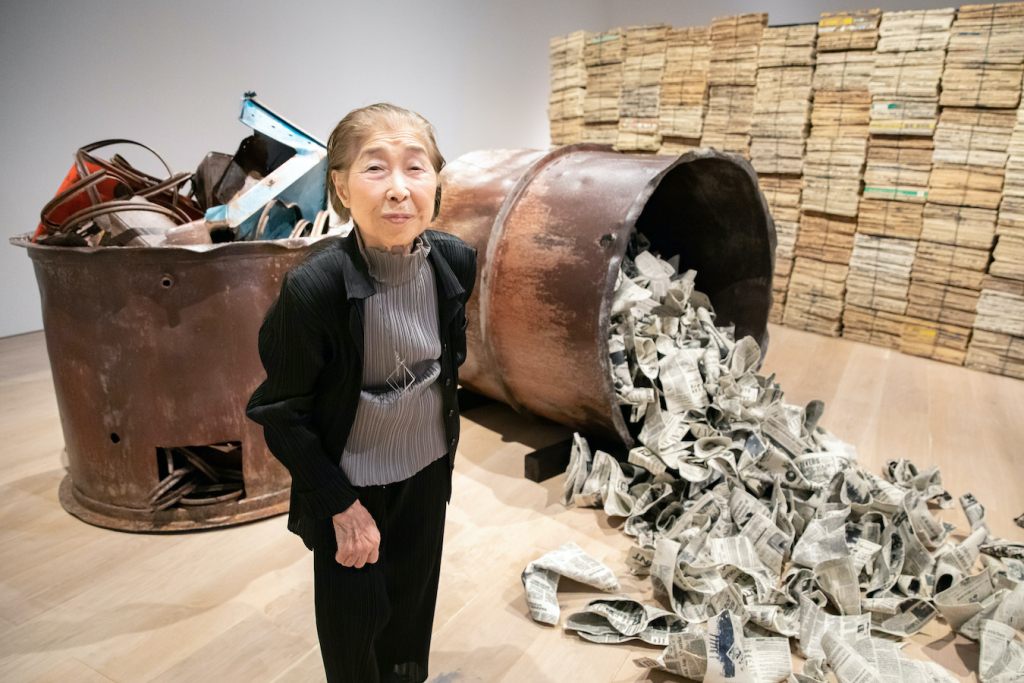In the 1971 seminal essay, “Why Have There Been No Great Women Artists?,” art historian Linda Nochlin contends that women artists have been so marginalized throughout history that masterful works of art have erroneously been attributed to men, with women being cast as the muse, oftentimes depicted in the nude form as described by the Western male gaze.
Nochlin says that feminist art is something that has been merely “grafted on to a serious, established discipline.” Rather than critically respond through an emotional retort, Nochlin says a new paradigm is to be created that “can become a catalyst, an intellectual instrument, probing basic and ‘natural’ assumptions, providing a paradigm for other kinds of internal questioning.”
Fifty years later, Nochlin’s new paradigm has finally arrived in Japan. Launched April 22, Mori Art Museum’s latest exhibition, Another Energy: Power to Continue Challenging–16 Women Artists from Around the World, displays the work of 16 female artists from ages 71 to 105.
Exhibition co-curator Martin Germann says the exhibition circumnavigates Nochlin’s essay, posing the question in today’s world, and focusing on the word “great.” “What is greatness?” says Germann. “Are they the rules that are imposed upon by men that decide what is great?”
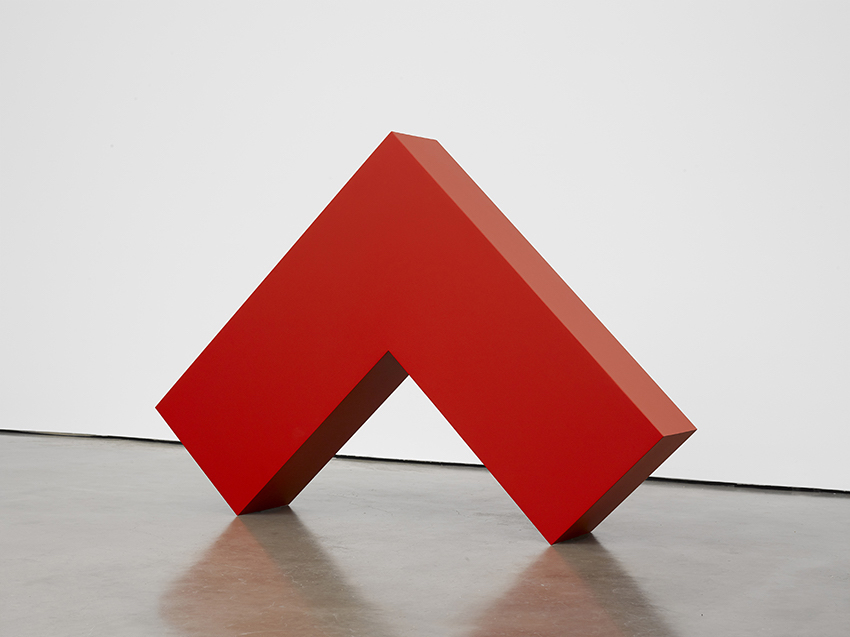
Carmen Herrera, Angulo Rojo (Red Angle) 2017-2018, Painted aluminum, 109.7 x 153.7 x 26.4 cm, Courtesy: Lisson Gallery
Mori Art Museum Exhibition Shifts the Paradigm in Japan
The simultaneous contrast of the Me Too movement, the Black Lives Matter movement and the Covid-19 pandemic shook up the world order of art, with critics and curators grafting diversity to the existing paradigm. With that, curators are amplifying the work and messages of female artists that will affect the course of the future, not only for the art world, but for politics, economics and the daily life of those staying at home during the pandemic.
“Corona has opened new doors to make us reflect and change,” says nomadic artist Anna Boghiguian in a video message that runs with her installation at the exhibition.
At a press conference for the exhibition opening, Mori Art Museum Director Kataoka Mami said a global trend has emerged over the past 10 years of reassessing and reevaluating female artists, and the Another Energy exhibition reflects that global movement.
“This is an exhibition about female artists, yes, but it’s not just about femininity or feminism,” said Kataoka. “The exhibition is too complex to say it is just a female exhibition. While gender is of course embedded in their consciousness as a part of a their broader awareness, it is not necessarily playing a central role in many of these artists’ practice.”
Kataoka co-curated the exhibition and worked with the Cologne-based Germann to recruit a diverse lineup with attention given to regional balance and theme. As such, 15 of the 16 of the artists reside outside of Japan and due to travel restrictions caused by the pandemic, were unable to make the trip to Tokyo for the exhibition opening. This included Germann, who provided a video message during the press conference.
“All [of the artists] started their careers in ‘60s and ‘70s in a time of turbulence, when art museums questioned the definition of art, and art became political,” said Germann. “There is also an obsession with the new by Modernists. We turned the page around. We look at careers. What did they do? What did they not do? This is looking at the future in the same way.”
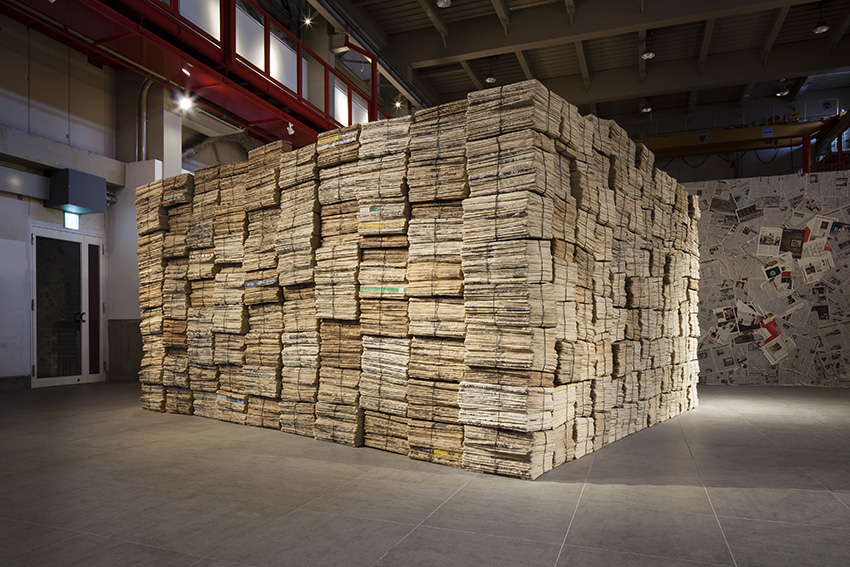
Mishima Kimiyo, Work 92-N, 1990-1992, Silkscreen on ceramic, 227 x 490 x 390 cm, Photo: Ogawa Shigeo, Photo courtesy: Bijutsu Shiryo Center, Tokyo
Kimiyo Mishima Takes the World by Storm – with a Smile
Kataoka said that viewers of the exhibition “will be blown away by the power of art without thinking about the artist’s age.”
Embodying this statement was Kimiyo Mishima, the only Japan-based artist, and the only artist in attendance at the exhibition opening. Kataoka said that when the 89-year-old Osaka native learned that 105-year-old active artist Carmen Herrera was taking part, that Kimiyo was inspired to create new work exclusive to the Another Energy exhibition.
“I am still young compared to 105,” said Kimiyo. “I am still young so I thought I could do a little more.”
“I am still young compared to 105”
During Japan’s period of intense growth in the 1970s, Kimiyo was amazed by the amount of information that was wontedly discarded immediately after consummation. Kimiyo’s “anxiety and fear towards the vast amount of information permeating society” is still apt in today’s digital world, and Kimiyo was compelled to install her new piece at Mori Art Museum.
Her signature sculptural pop art style involves crafting figurative ceramic pieces that are then covered in silkscreen printings of newspapers, magazines and other discarded media, a practice she calls “a continued effort at creating waste.” For three months Kimiyo tirelessly crafted crumpled ceramic newspapers that appear to tumble out of a large trash bin. Kimiyo, who was escorted into the press conference in a wheelchair, said she didn’t realize how sore her legs were until she had completed her project.
“I gave all my effort to create this,” said Kimiyo, standing before a crowd of reporters as they snapped her picture. “I just want to finish out my determination. To me, that is fun.”
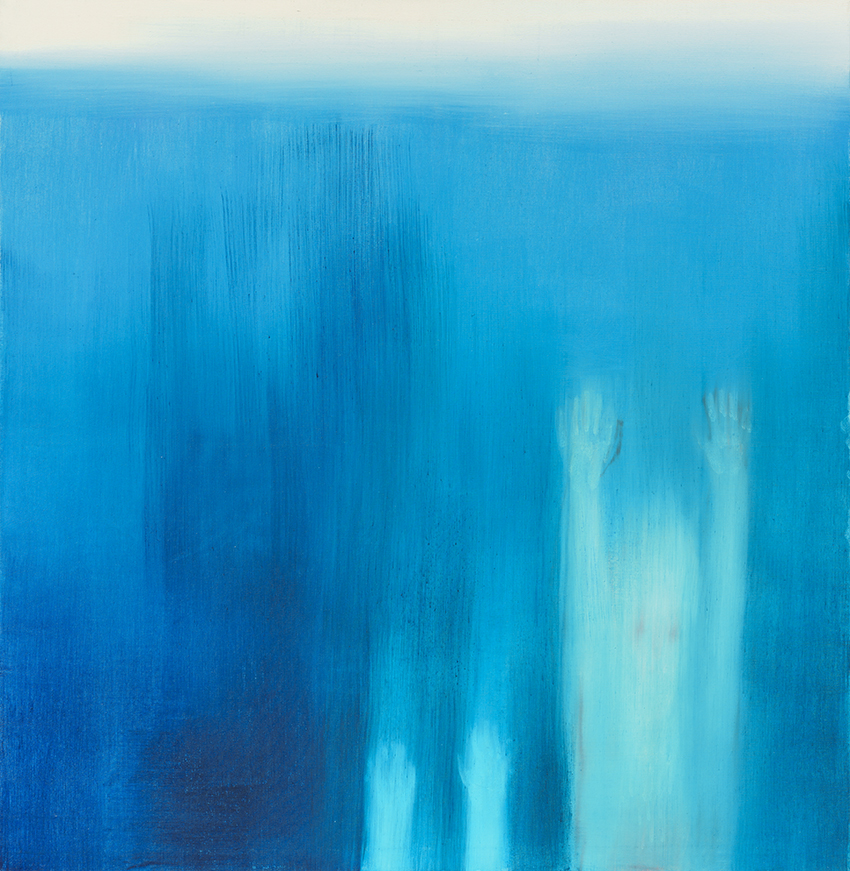
Miriam Cahn, das schöne blau(the beautiful blue), May 13th, 2017, Oil on canvas, 200 x 195 cm, Collection: WAKO WORKS OF ART, Tokyo
Covid-19 Makes the Challenge Even Greater
Completing the exhibition was an act of determination for Kataoka and Germann. They began plotting the exhibition in 2015 when Germann introduced Kataoka to the work of Belgian artist Lili Dujourie, whose solo exhibition Germann was curating at the time, and eventually earned him the AICA Award for Belgium’s best exhibition. The duo started curating Another Energy two years ago, then the pandemic hit. Germann was stuck overseas, and Kataoka and Mori Art Museum staff were forced to produce art installations over Zoom chat.
Without a blueprint, London-based sculptural artist Phyllida Barlow gave vocal instructions to curators over Zoom to piece together her mammoth installation of hanging textiles and 78 large styrofoam balls.
“I said, ‘Do you need all 78 balls?’ and she said, ‘Yes, we need all of it,’” said Kataoka. “She is a challenger.”
Perhaps the most recognized artist on exhibit is Swiss painter Miriam Cahn, who is particular about her paintings being installed in the line of sight, and also had to provide directions to curators over Zoom. While some artists’ work blends methodology and delivers abstract messages – such as Chicago-based artist Senga Nenjudi who combines sculpture with performance art – Cahn’s work will punch you in the face. Her vibrantly colored oil paintings and powerful charcoal drawings use harsh imagery of discrimination, war and violence to deliver home the contradictory message of harmony and tolerance.
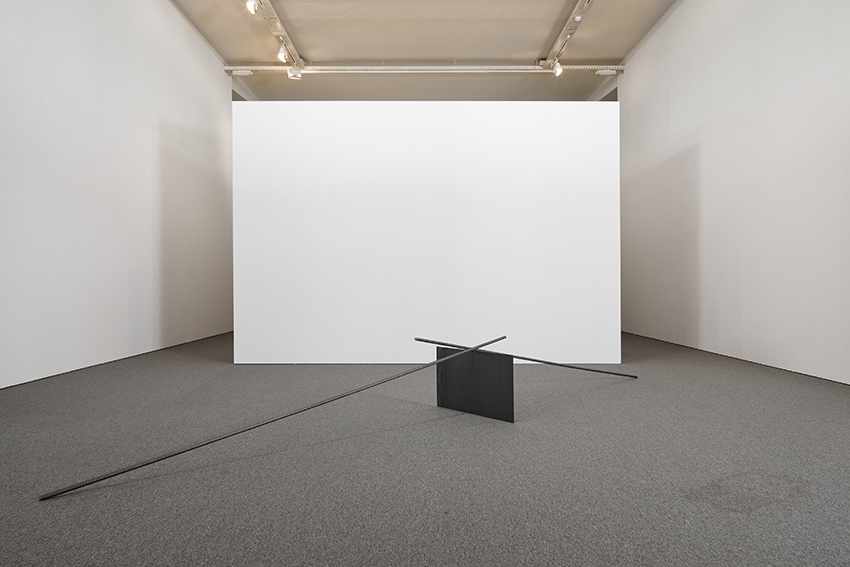
Lili Dujourie, Untitled (Balance), 1967, Steel and iron plate: 45 x 75 x 0.3 cm, bar: 300.6 x φ 2.2 cm, Installation view: Folds in Time, Mu.ZEE, Ostend, Belgium, 2015, Photo: Dirk Pauwels
Lili Dujourie Challenges Perceptions
At the center of the exhibition is an installation by the artist who inspired it all – Lili Dujourie.
“One of the characteristics of Lili is she is very subtle in her expression but poetic and beautiful,” said Kataoka. “She ripped paper into pieces and posted it to the wall. She called it a landscape. I have seen many artworks but when I saw this I said, ‘Oh wow, this kind of artwork can still exist.’ My heart was cleansed.”
Entering the room at Mori Art Museum hosting Dujourie’s contribution to the exhibition, viewers are first stunned by the floor-to-ceiling windows offering a panoramic view of Minato ward, but the contrasts and structures of the installation knock you off kilter. It is fitting that the central piece is titled, “Untitled (Balance),” as the steel rods teetering on a steel plate fail to meet at a congruous point.
“The energy is in yourself to go for it. Even it will be bad or good, I don’t know before”
Dujourie produced provocative video and photography in the 1970s when gender equality was still rife in her Belgian homeland. Women were unable to rent property on their own and men were required to sign official documents. By using her own body as subject for her art, she took the ownership of the female nude away from the male artist, tipping the scales of inequality within the art world.
The deliberate presentation of the installation at Mori Art Museum is like a minimalist, abstract Japanese rock garden where meditation comes natural yet an uneasy stillness permeates. Says a quote by Dujourie on the wall: “The energy is in yourself to go for it. Even it will be bad or good, I don’t know before.”
Another Energy: Power to Continue Challenging–16 Women Artists from Around the World is on exhibit at Mori Art Museum from Apr 22, 2021–Jan 16, 2022.
Exhibition of the following two works will end on Sep 28: Victoria (2017) by Carmen Herrera; and Cargueros de Bucamaranga (Bucaramanga Porters) (2006) by Beatriz González.
Visit mori.art.museum/en for more information. Be sure to read the museum’s countermeasures against Covid-19 upon your visit.
Feature photo of Mishima Kimiyo by Tayama Tatsuyuki, photo courtesy of Mori Art Museum, Tokyo
Updated On September 14, 2021

